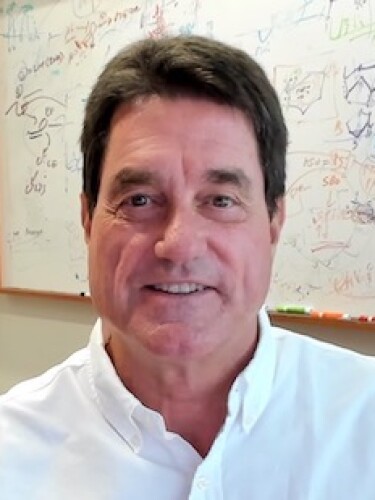As Vertex and CRISPR Therapeutics’ exa-cel and Verve Therapeutics’ VERVE-101 move forward, questions remain about possible drawbacks of such therapies.
Pictured: An hourglass connected by strands of DNA/Nicole Bean for BioSpace
Updated upon FDA approval exa-cel.
Original story published Dec. 8:
The FDA today signed off on Vertex Pharmaceuticals and CRISPR Therapeutics’ exa-cel for sickle cell disease. And earlier this fall, the regulator greenlit the first U.S.-based in vivo base editing trial, run by Verve Therapeutics. These actions suggest the agency deems the investigational gene-edited therapies sufficiently safe for human use and study. But as with any new modality, experts say risks remain.
The Oct. 31 adcomm for exagamglogene autotemcel (exa-cel) focused on whether Vertex and CRISPR had conducted a sufficiently thorough analysis of the therapy’s potential off-target effects.
Exa-cel contains hematopoietic stem and progenitor cells (HSPC) edited using CRISPR-Cas9, which has the potential to produce off-target genomic alterations. During gene editing, cells can experience unintended cuts in their DNA, resulting in mutations that can lead to unwanted cell growth. So ensuring safety requires an understanding of where these accidental cuts may occur.
“The biggest safety event that people are concerned about in general is editing in a place in the genome that could lead to cancer,” said Verve co-founder and CEO Sekar Kathiresan. “That’s really what I think the biggest concern is from a long-term safety perspective.”
In briefing documents published ahead of the meeting, the FDA said the in silico methods used by the Vertex and CRISPR to spot potential unintended edits used “insufficient sequencing data.” The regulator expressed concern that the limited amount of sequencing data in the reference database “may not adequately capture variants” in the target patient population.
But Martin Steinberg, a hematologist at Boston University and a member of Vertex’s exa-cel steering committee, noted that the companies conducted a variety of tests looking throughout the genome for sequences that might be targeted by the guide RNA.
“They did . . . in silico and in vitro testing to nominate possible sites,” Steinberg told BioSpace. “They were looking for actual damage to these sites and cells, and there’s nothing that’s shown up that’s concerning in any way, at least in the short term.”
Monitoring for Long-Term Effects
Ultimately, FDA advisers recommended that Vertex and CRISPR could follow patients who received exa-cel treatment for possible off-target effects. “We want to be careful to not let the perfect be the enemy of the good,” Scot Wolfe, a professor at the Department of Molecular, Cell and Cancer Biology at UMass Chan Medical School and an adcomm member, said during the meeting.
Steinberg said the patients will be followed for two reasons: first, “to look for something that we don’t expect that might be caused by off-target effects,” and second, for persistence of efficacy.
Kathiresan said he believes the risk is “extremely low. Based on the work that [Vertex and CRISPR Therapeutics] have done . . . they don’t find any concerning off-targets or any cancer-causing genes.” He noted, however, that the chemotherapy drugs given to patients as part of a conditioning treatment prior to infusion of the edited cells can potentially contribute to cancer.
Eric Kmiec, founder and executive director of the ChristianaCare Gene Editing Institute, said the risk-benefit ratio is also a consideration. “If you are trying to treat . . . mid-stage to late-stage cancer patients, the off-target stuff is not as important there as it would be to a child with sickle cell disease . . . [who] now has 40 years to find out whether or not something we couldn’t detect by our current technology has now caused a long-term tumor,” he said.
Base Editing: A Safer Option?
One modality that could limit the potential for off-target effects is base editing. CRISPR-Cas9 is “kind of like genetic scissors” that can be programmed to cut precise locations within the DNA strand, Kathiresan said. In contrast, base editing chemically modifies one of the nucleotide bases, commonly abbreviated as A, T, C and G, that make up the DNA. In other words, the “scissors feature [has] been replaced with an enzyme that actually changes one letter to another letter,” Kathiresan explained. Therefore, he said, base editing approaches, such as that used by his company, avoid the mutations that come with cutting the DNA.
“It reduces even further the number of potential off-target edits,” agreed Steven Dowdy, a professor of cellular and molecular medicine at the University of California, San Diego. With a base editor, “not only do you have to target the gene but you have to have a target cytidine or adenosine within reach of the base editor fused to Cas9.”
Cambridge, Mass.–based Verve has a “laser-like focus” on preventing heart attacks through the long-term control of low-density lipoprotein (LDL) cholesterol, Kathiresan said. The company’s base-editing approach aims to capitalize on the discovery that some people without a working copy of the PCSK9 gene have very low LDL throughout their lifetimes and that those people are “remarkably protected from heart attack,” he added. Verve makes a “single spelling change” in one spot in the genome to turn off the PCSK9 gene.
As Verve is going after a very common condition, “we wanted every inch of potential safety advantage,” Kathiresan said. Still, he acknowledged base editing isn’t without its own risks: “You’re making that single spelling change in one place [in the genome] . . . and you have to look to see, are you making it anywhere else? And even if you’re making it somewhere else, is that a problem?”
The company recently reported its first clinical data from a Phase Ib study conducted outside the U.S. The data showed that treatment with the investigational therapy, VERVE-101, led to clinically meaningful LDL cholesterol reductions after six months of follow-up, Kathiresan said.
There were, however, two serious cardiac events among patients in the trial. In the first instance, a patient with cardiomyopathy suffered a fatal cardiac arrest five weeks after infusion of VERVE-101. The second patient had a heart attack one day after infusion. While the second case was labeled as “potentially related” to the treatment due to its proximity to dosing, in both cases, investigators concluded the events stemmed from the patient’s underlying conditions. “We treated patients who had severe advanced heart disease because that’s what we were guided to by the FDA,” Kathiresan said.
The independent data and safety monitoring board had recommended continued dosing, and the FDA had reviewed the entire data package, including the clinical data with these safety events, Kathiresan said, before giving Verve the green light to begin the study.
“This is sort of the first time we’ve had to worry [about] a tool specifically designed to change the genetic code and make sure that it works predominantly at its site, and I’ve always thought about it as ‘to do no harm,” Kmiec said.
Ultimately, Dowdy said the specificity of genetic medicines makes them safer than small molecule drugs. With small molecules it is impossible to predict what unintended proteins it may bind to, he said. “With these genetic medicines, we can actually see what the off-targets are and improve. Without a doubt, it’s a brave new world of medicine, and once the delivery problem is solved, you may never take a small molecule drug the rest of your life.”
Heather McKenzie is a senior editor at BioSpace. You can reach her at heather.mckenzie@biospace.com. Follow her on LinkedIn.








